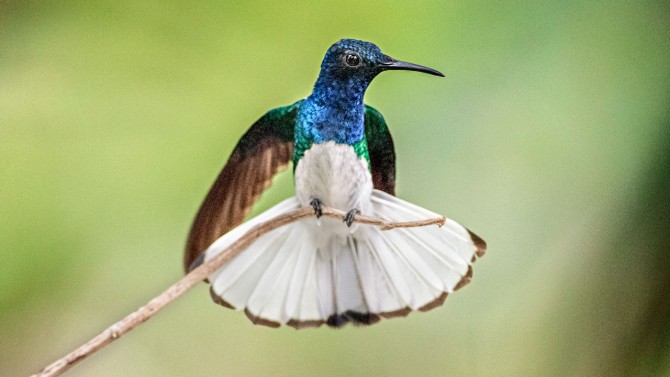Female hummingbirds look like males to evade harassment
By Pat Leonard
New research on the glittering white-necked jacobin hummingbird reveals nearly 20% of the species’ adult females have male-like plumage. Why? To dodge bullies and get better access to food, according to new Cornell research.
The findings were published Aug. 26 in the journal Current Biology.
“What’s interesting about the white-necked jacobin is that all the juveniles start out with male-like plumage,” said lead author Jay Falk, Ph.D. ’20, who did the research with the Cornell Lab of Ornithology as a doctoral candidate. “Among most other bird species, juvenile plumage looks more like the female’s, presumably to be less obvious to predators.” His co-authors are Michael S. Webster, Ph.D. ’91, the Robert G. Engel Professor of Ornithology and director of the Lab of Ornithology’s Macaulay Library; and Dustin R. Rubenstein, Ph.D. ’06, of Columbia University.
As the birds mature, all jacobin males retain the fancier plumage – but so do nearly 20% of the females among the population Falk studied in Panama. The remaining 80% of females develop the muted green and white coloration of a typical adult female.
So, what’s the benefit to females of this species when they look like a male? To solve that puzzle, Falk and his assistants put radio frequency ID tags on birds and set up a circuit of 28 feeders wired to read the tags. By tracking the number and length of visits, they homed in the answer.
“Our tests found that the typical, less colorful females were harassed much more than females with male-like plumage,” said Falk, now a postdoctoral fellow at the University of Washington. “Because the male-plumaged females experienced less aggression, they were able to feed more often – a clear advantage.”
The researchers found that the male-like females got to feed longer than the typical adult female – about 35% longer at feeders filled with high-sugar nectar. That can make a big difference in their ability to thrive, because hummingbirds have the highest metabolic rate of any vertebrate. They need to eat constantly in order to survive.
Female white-necked jacobins retain the male-like plumage of their youth for social reasons: They avoid the bullies by looking like them. It is unclear whether male-like females behave just as aggressively as the males. The physical mechanism that allows females to retain male-like plumage is also unknown.
The white-necked jacobin is hardly alone when it comes to having some females that look like males. Falk says studies have found that 25% of the world’s more than 350 hummingbird species also have some females that look like males.
Though plumage ornamentation is usually attributed to sexual selection and attracting a mate, researchers ruled out that explanation for this species after field experiments.
Scientists observed the reactions of live jacobin hummingbirds toward stuffed mounts placed on nectar feeders during breeding season. The mounts were stuffed specimens of adult white-necked jacobin males, typical adult females, and female adults that looked like males.
“If females having male-like plumage is the result of sexual selection, then the males would have been drawn to the male-plumaged females,” said Falk. “That didn’t happen. The male white-necked jacobins still showed a clear preference for the typically-plumed adult females.”
Funding for the research was provided by the Cornell Lab of Ornithology, the Smithsonian Tropical Research Institute, the National Science Foundation, the Society for the Study of Evolution, the American Society of Naturalists, and the Sigma Xi Society.
Pat Leonard is a staff writer at the Cornell Lab of Ornithology.
Media Contact
Get Cornell news delivered right to your inbox.
Subscribe

